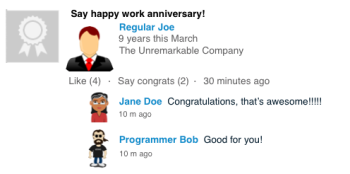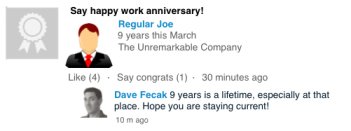Career Stagnation – Early Detection and Treatment
Have you ever been on LinkedIn and stumbled on one of their work anniversary announcements? In case you haven’t, they look something like this:
The announcements are generated by LinkedIn and typically followed by a predictable handful of likes, congratulatory words, and positive sentiments. I’m yet to see a comment that generally reflects my knee-jerk reaction to at least some of these posts.
Longevity and career stability obviously don’t have to be a bad thing, but I’ve seen far too many programmers become so comfortable in a job that they don’t bother to take a look outside to see what changes are going on outside of their bubble. When these professionals eventually decide to seek new employment, usually by way of some triggering event such as a layoff,they are usually stunned by how much the hiring landscape has changed since their last job search. This is a conversation I’ve had hundreds of times, where my role begins as educator (“JavaScript is actually pretty popular these days.”), morphs into advisor (“You might want to brush up your web skills.”), and eventually lands on crisis counselor (“It’s going to be OK.”).
Stagnation: How it happens
The formula for career stagnation is pretty simple. When one’s basic needs are met or even exceeded, they stay put. When provided with fair compensation, a tolerable work environment, and a comfortable chair, many technologists go about their work without finding the need to pay much attention to trends in the industry that don’t affect them. In an industry that changes rapidly, the result is marketability problems.
For some in our field, new challenges, learning, and change are basic needs. Even if these types are paid well and given other perks, they will be likely to investigate trends and possibly seek new employers. Their natural curiosity protects them from stagnation.
Managers hire technologists who possess the skills needed to perform jobs at their company, even if those skills are not in high demand on the overall job market. Those working for companies staying current with new tools and offering multiple challenging projects have no reason to fear the negative impact stagnation has on marketability. For those working in static environments with little change and a dependence on less popular or proprietary technologies, the burden of maintaining marketability is their own.
Avoidance, Detection, and Treatment
The biggest problem with stagnation is that technologists don’t realize it’s even an issue until it’s too late to remedy. Thankfully, there are ways to identify and treat this common problem.
- Diagnose – Set a reminder on your calendar to update your résumé and/or LinkedIn profile every six months. Are you able to add any projects or skills to your résumé? Are there any skills on your résumé that you no longer feel comfortable including for fear of being exposed as a fraud? How many six month periods have passed since you have been able to mark a significant accomplishment?
- Test – Send your résumé to a past co-worker – ideally someone who has been on the job market a bit – or a recruiter you trust, and ask if your current skills would get you interviewed. Make it clear that you aren’t actively seeking employment, but now are just interested in an assessment.
- Read and get out – Much of stagnation is related to technologists being insulated professionally and not paying attention to trends outside their offices. Reading technology blogs or article aggregators for as little as an hour per week will give you an idea if you are building marketable skills. Having any involvement with others in the industry that are not co-workers is perhaps the most valuable method of prevention. Some office environments may fall prey to groupthink and hive mind tendencies, so communication of any kind with the outside world is useful.
- If you aren’t getting it at work, get it at home – If your employer doesn’t provide you with the ability to work on challenging projects and relevant technologies, side projects are one solution if you have the time. Employers today tend to appreciate self-taught skills and impressive independent development efforts as much as on-the-job experience.
- Leave – Leaving your job doesn’t need to be the first solution to career stagnation, but for many it’s the most effective. When evaluating new employers, consider whether stagnation and marketability issues may arise again in the near future.
Marketability is a complex concept that depends upon several independent factors that are difficult to predict. Stagnation is easier to diagnose than it is to treat. Early detection is the key.
| Reference: | Career Stagnation – Early Detection and Treatment from our JCG partner Dave Fecak at the Job Tips For Geeks blog. |







